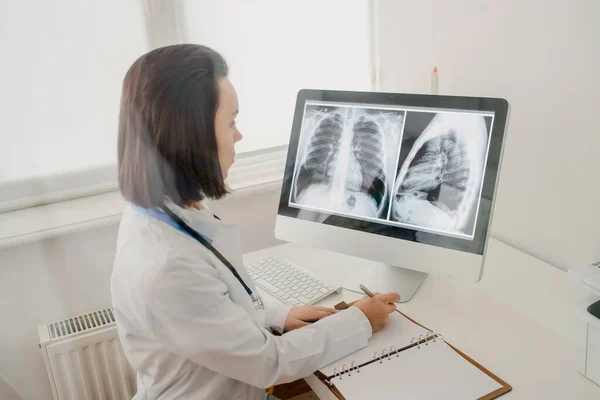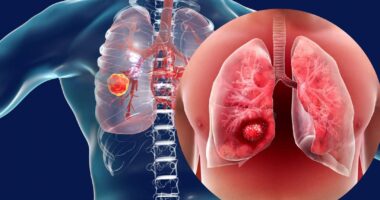Determining the absolute “first sign” of tuberculosis (TB) can be tricky because the infection develops in two stages, each with different characteristics.
Tuberculosis (TB) is a contagious infection caused by the bacterium Mycobacterium tuberculosis. It primarily affects the lungs but can also spread to other parts of the body, such as the kidneys, brain and spine. While commonly associated with lung complications, it’s important to remember that TB can be a diverse disease with signs and symptoms.

The first sign of tuberculosis (TB) can vary depending on the type of infection. In most cases, the initial symptoms are mild and may include a persistent cough that lasts for more than three weeks. This cough may be dry or productive (producing phlegm), and sometimes blood-tinged.
Other symptoms of active TB in the lungs may include:
- Loss of appetite and unintentional weight loss
- Fever
- Chills
- Night sweats
- Chest pain
- Pain with breathing or coughing
- Weakness or fatigue
As earlier mentioned, tuberculosis (TB) can progress through different stages, each with its own characteristics and implications. Here are the general stages of TB:
Exposure: This is the initial stage when a person comes into contact with someone who has active TB. The bacteria may enter the body, but there may be no symptoms or signs of infection.
Latent TB infection (LTBI): In this stage, the bacteria remain dormant in the body, causing no symptoms and not being contagious ( around one-quarter of the world’s population have LTBI). The immune system usually keeps the bacteria in check, preventing them from multiplying and causing disease. However, the bacteria can become active if the immune system weakens due to medical conditions and inadequate nutrition and the the person may test positive for TB infection.
Active TB: If the immune system becomes compromised, the bacteria can become active and start multiplying. Active TB can affect the lungs (pulmonary TB) or other parts of the body (extrapulmonary TB). Symptoms may include persistent cough, fatigue, weight loss, fever, and night sweats. Active TB is contagious and requires treatment to prevent further transmission.
If TB affects the lungs, it can also cause coughing up blood or mucus (sputum). In some cases, TB symptoms may not begin until months or even years after the initial infection, and the infection can remain latent without causing any symptoms. However, if left untreated, latent TB can progress to active TB, which can be more contagious and potentially life-threatening
Another stage of Tb is the Drug-resistant TB: In some cases, the bacteria can develop resistance to the standard antibiotics used to treat TB. This is known as drug-resistant TB and requires specialized treatment.
TB classified based on the affected area:
Pulmonary TB: This is the most common type, affecting the lungs.
Extrapulmonary TB: This type affects other parts of the body, such as the bones, joints, lymph nodes, brain, kidneys, and genitals.
Miliary TB: This is a rare form of TB in which the bacteria spread through the bloodstream and form tiny nodules in various organs. The type of TB a person has will determine their symptoms and treatment options [Sources: CDC, Minnesota Dept. of Health]
DON’T MISS: Scientists Get Funded To Study Tuberculosis Drug Development
What Causes TB?

Tuberculosis (TB) is caused by a type of bacteria called Mycobacterium tuberculosis. These bacteria are incredibly tough and have a waxy coating that makes them resistant to many common antibiotics and harsh environments.
It’s important to know that not everyone who comes into contact with the bacteria will develop active TB. Several factors can increase the risk of developing TB after exposure, including:
- Weakened immune system: Individuals with weakened immune systems, such as those with HIV/AIDS, cancer, or certain medical conditions, are more susceptible to developing active TB. Next read 6 Legit Ways to Support Your Immune System, According to Doctors
- Close contact with an infected person: Spending prolonged periods with someone who has active TB can increase the risk of transmission.
- Living in crowded or unsanitary conditions: TB spreads more easily in overcrowded areas with poor ventilation and limited access to healthcare.
- Traveling or living in areas with high TB prevalence: TB is more common in certain regions, particularly in developing countries with limited healthcare resources.
Additional factors that can increase the risk of developing active TB from latent TB include: malnutrition, smoking, alcoholism, and diabetes.
It’s important to remember that TB is not simply caused by “poor hygiene” or living in “poor conditions”. Although these factors can increase the risk of transmission and progression of the disease, anyone can contract TB by inhaling the bacteria. This is why prompt diagnosis and treatment are crucial to prevent both individual complications and further spread of the infection [Source: researchgate].
Transmission: How Does TB Spread?

Tuberculosis (TB) is contagious and primarily spread through the air when an infected person coughs, sneezes, speaks, or even sings. The bacteria, Mycobacterium tuberculosis, are released into the air in small droplets that can be inhaled by others. However, it’s important to note that not everyone who is exposed to TB becomes infected or develops active TB disease. The risk of transmission is higher when there is prolonged and close contact with an infected person, especially in crowded or poorly ventilated settings. Prompt diagnosis and treatment of active TB can help prevent further transmission [source CDC].
Prevention: How To Avoid Catching TB

Preventing Tuberculosis (TB) involves a multi-pronged approach targeting both individual actions and public health initiatives. Here are some key strategies:
Individual Level:
- Vaccination: The BCG vaccine, while not perfect, can offer some protection against developing TB, especially in childhood. However, the recommendation for vaccination varies depending on the region and risk factors.
- Early diagnosis and treatment: If you have symptoms suggestive of TB, seeking prompt medical attention is crucial. Early diagnosis and completing the full course of antibiotic treatment can prevent further complications and transmission.
- Hygienic practices: Covering your mouth and nose when coughing or sneezing, practicing good hand hygiene, and maintaining proper ventilation in enclosed spaces can significantly reduce the risk of spreading TB.
- Addressing underlying conditions: Individuals with weakened immune systems due to HIV, malnutrition, certain medications, or chronic illnesses are at higher risk of developing active TB. Managing these underlying conditions can help strengthen the immune response and potentially prevent TB progression.
Public Health Level:
- Enhanced case finding and contact tracing: Identifying individuals with active TB and tracing their contacts to ensure they get tested and treated if necessary is critical for breaking the chain of transmission.
- Improving access to quality healthcare: Ensuring everyone has access to affordable and effective TB diagnosis, treatment, and preventive services is essential for controlling the spread of the disease.
- Investing in research and development: Ongoing research on new vaccines, diagnostics, and treatment regimens is crucial for improving TB prevention and control efforts.
- Addressing social determinants of health: Poverty, overcrowding, and poor living conditions can increase the risk of TB transmission. Addressing these social determinants is essential for long-term control of the disease.
Additional Tips:
If you live in a region with a high TB burden, be aware of the risk factors and symptoms.
- Avoid close contact with individuals with active TB.
- Seek medical advice if you experience persistent cough, weight loss, night sweats, or other TB symptoms.
- Raise awareness about TB in your community and advocate for better prevention and control measures.
By combining individual efforts with strong public health interventions, we can significantly reduce the global burden of TB and work towards a future free from this devastating disease.
RELATED: Evolution of Tuberculosis: New Insights and Facts










